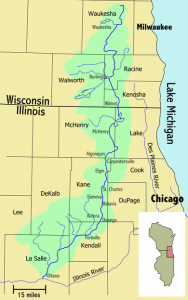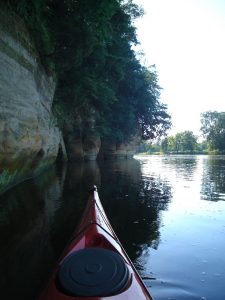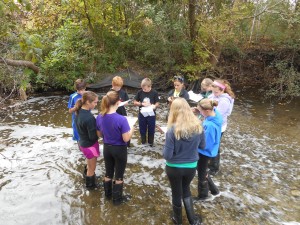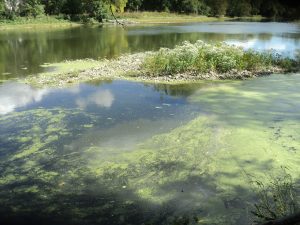Article written for the April 2017 “Bravo Magazine” by Dean Tripp
Our Fox
By its very nature a river belongs to more than one people, place and time. Our Fox is no exception. The water flowing into and out of it is a resource we can’t create or destroy; we can only attempt to manage its uses, and so, its quality. This article examines the local conscience for protecting “Our Waters, Our Fox” – our part in managing what covers 70% of the planet’s surface – particularly the 400 gallons per second (10 year average) that flows through the Fox Valley.
Ancient Ice
Over 11,000 years ago there was an icy phenomenon of nature that covered and shaped most of what is now Canada and what we now call our Upper Midwest. This included most of Wisconsin for which that icy force now bears that name, The Wisconsin Glaciation Episode. In any event it was that ancient ice – by its dozing, gouging and grinding, as it advanced to the south, then its melting, flooding, leveling and percolating, as it receded to the north – that left us with not only the geography of most of the state of Wisconsin, but much of the Upper Midwest and the Northeast of the U.S. That includes the Great Lakes, as well the less dramatic origins and upper reaches of our own Fox River watershed. That is, the ground that drains into Our Fox.

The river’s headwaters begin in the “Halbach Swamp” about 15 miles northwest of Milwaukee. Further south, in both Wisconsin and Illinois the retreating ice left behind spectacular moraines and kames. It also left massive gravel fields below layers of top soils (which are being mined in the Fox Valley today). Indeed, as the glacier melted it also flooded large areas of northern Illinois leaving fluvial plains which created vast areas highly suitable for agriculture. As these landforms absorb rainfall, the coarser gravel and finer sands underneath filter the rainfall. This filtered water recharges our aquifers, wetlands, the many tributaries of Our Fox, and the river itself.
Our Fox River’s watershed is some 223 miles long, from the Wisconsin headwaters to The Fox’s mouth where it flows into the Illinois River at Ottawa, IL. As it flows south down its final stretch to the Illinois River, the Fox travels through some older geography and landforms that were not reached by the Wisconsin glacier. The “Dells” of the Fox retain the work of still older periods of erosion that left rock outcroppings and dells, similar to the Wisconsin Dells and Driftless areas.
The Good Life Then and Now
As one might suspect, the waters of the Upper Midwest, including those of Fox River’s watershed, were never fuller than when the glacier was melting. The water bodies and streams it left behind supported a growing, robust ecosystem.
That ecosystem however now included the human ecology of “First Peoples” that followed the retreating glaciers. Ten millennia later those people, now in more developed and civilized settlements, were here to meet migrations of both indigenous peoples, and Europeans, from the East and North.
These later times were still good times for the Many Waters, when the indigenous people across the continent were still integrated with the rest of nature that surrounded them, and upon which they knew they and all other sentient life depended. In retrospect, theirs was a natural, ecological ethos. That is their ways of thought, feeling and living with nature were time-honored, respectful of it, even reverent, especially of water for all the life-supporting purposes it served. Like us now, it quenched their thirst, helped them cook and clean, supplied them food, lent speed to their waterborne transportation, and for the more settled, helped them grow and raise their plants and stock. Mind you, it served all these purposes with no intervening treatment and certainly was as beautiful to them as it is to us today.
The First People’s view of what surrounded and supported them and their good life lacked the concept of owning. As their traditions are told, there was no gathering, hunting, fishing, growing or extracting at any scale with adverse impacts, but rather only what met their immediate and seasonal needs, while being grateful for it and leaving plenty for regeneration.
But of course, that was “then”, which had been so for many millennia and was so when Europeans landed in the 16th century. Even after that, the Upper Midwest remained largely unsullied if not pristine, well into the 19th and even the early 20thcentury, at least for the rural and remote. Yes, that was then and then was good, or certainly better, ecologically. But the rest of this story is about now.
Our Impaired Fox
What does this mean (“Impaired”)? Who has said so? How did this happen?
Webster’s New World Dictionary says in its past tense the meaning of “impaired” is akin to “injured”, “damaged” or “deteriorated”. Regarding Our Fox, all of the above still apply, at least according to relatively recent reporting (2016 Illinois 303 d List) of the Illinois Environmental Protection Agency (IEPA) to the U.S. Congress.
How this came to be is not a very long story. After all, we’re not a very old nation as nations go. So the question of “how” demands an answer. Meaning, if we want to take some responsibility for what’s happened to the ecosystems of the planet in recent centuries, including Our Fox, it’s pretty clear; it’s Humankind which has damaged the natural world, which we still depend on for our very existence. Indeed, as the preamble to this story states, “Our Fox is no exception.” In fact, the Fox was at one time listed “among the 10 most endangered rivers in America”. So, bad as it sounds, “Impaired”, in this case also means “somewhat improved”.
To be more specific about how all this happened, it was the usual process of growth and development. Tiny settlements and villages in turn grew into towns, and some into cities. In our watershed that might include Gilberts, with less than 100 souls in the mid-20th century, a harmless country hamlet until the 1970’s. Or an early industrial village like Carpentersville with a few hundred souls and a wooden water wheel that powered the Illinois Iron & Bolt Works. Our Fox ran free past the town until the construction of its dam for generating electricity for Star Manufacturing. East Dundee’s Haeger Pottery, used spring water to turn clay and slip into their famous products…and the waste from those processes into unfiltered effluent. Or take Elgin, which at one time, hosted the heavy industry of the Woodruff & Edwards foundry.
The Fox River didn’t become impaired only by the impacts of industrial pollution. There were decades upon decades, before and after the advent of indoor plumbing, when human waste was drained or piped straight into tributaries of the Fox and the Fox itself. Indeed under-built and over-worked treatment plants that result in under-treatment of effluent and pollutants are still a problem.
Clearly, the Fox has had to carry a burden of pollutants for a long time. The load on treatment plants for drinking water at the front end of our water use, and release of treated effluent after our use, is still mounting. Indeed, given the chemical nature of what leaves our homes and businesses now, as Gary Mechanic, Executive Director of Friends of the Fox River, has so aptly implied, we are now making obsolete the past’s popular wisdom that: “the solution to pollution is dilution”.
The Good News
Much of this bad news may not be news to many readers, so we won’t belabor it further. Moreover, not all the news of this story is bad. For in recent years the quality of the Fox has improved, albeit not by accident. So we’re going to say more about that, as the quality of our future may well depend upon the sort of research and educational efforts which have helped make that improvement.
The good news is that there are some very able professionals working in very dedicated organizations to best understand the ecology of Our Fox and its watershed and enable improvement of its quality. The list of these professionals is long, while that of the organizations in which they work, though not as long, are too much to treat meaningfully here. Such being the case, we’ll try to proffer something significant about two of the leading organizations and their work, and some of their leaders, primarily those who are common to, or have history with both organizations, which we think speaks to their private as well as their professional dedication.
Our Fox’s Friends
One of these organization, incorporated as a 501 (c)(3) Not For Profit (NFP) in 1990, is Friends of the Fox River (FOFR). They originated in the Elgin/Dundee area and developed the Schweitzer Environmental Center in Dundee Township.
It seems fair to say that the Friends leading work and strongest thrust is educational, particularly with school districts, ranging from Crystal Lake to Aurora. FOFR also fields a Watershed stream monitoring program, river cleanups and varied annual and special events. It counts the famous James F. Phillips, aka “The Fox” among its early inspirations for forming.
The mentioned emp hasis on education is best reflected in the work of its longtime President, Gary Swick, a retired Carpentersville environmental science teacher and presently an instructor at Northern IL University. Swick’s methods rest on an obviously passionate enjoyment of the Fox and his professional belief in experiential education “Get ‘em in the stream.”, being his longtime motto! Swick recently delivered a presentation to other Friends and supporters this past January at the Schweitzer Center, aptly titled “The State of the Fox and Friends”.
hasis on education is best reflected in the work of its longtime President, Gary Swick, a retired Carpentersville environmental science teacher and presently an instructor at Northern IL University. Swick’s methods rest on an obviously passionate enjoyment of the Fox and his professional belief in experiential education “Get ‘em in the stream.”, being his longtime motto! Swick recently delivered a presentation to other Friends and supporters this past January at the Schweitzer Center, aptly titled “The State of the Fox and Friends”.
Not surprisingly it was educational, as well as funny, confirming that though the river is still impaired, there is also a lot of recent data indicating it is improving. He offered stats to reinforce that claim but summed it in his characteristic style, wryly commenting about the improving fish populations: “Fish don’t lie.”
There was much more to take away including the very important point that it will be cultural change, at the level of household lots and other properties that will significantly further improvement of the Fox’s water quality.
Swick mentioned some measures that you can take at home including installing rain barrels, rain gardens, vegetated swales, porous drives and walkways. The concept here is that runoff from roofs, paving and even that from lawns, which ultimately leaves your property, collects all sorts of pollutants on its way to storm drains that take it right into the river! This is something that can obviously be headed off with thought for Our Fox.
Swick also described storm water management problems presented by the twelve obsolete dams remaining on Our Fox between the State Line and Yorkville. These dams hold back sediment as they slow the flow of water, which darkens it and absorbs more sunlight, holding heat and raising temperature. This is not good for most fish and other living things indigenous to Midwest river ecosystems.
Clearly, not only do we need to take more personal responsibility for what happens to the rain that falls on our roofs and private property, but also to persuade officials and the public to remove more dams to accelerate improvement of the water and biological quality of Our Fox.
Group Study
The second organization is the Fox River Study Group (FRSG), also incorporated as an NFP (2003) with its mailing address in Oswego, but whose meeting places vary. The FRSG’s area of study begins at the WI/IL state line and extends down to the mouth of the Fox at Ottawa.
There is another very pressing problem which has been tackled head on by the FRSG. Chaired by Cindy Skrukrud who was a former President of the FOFR, and is currently the Clean Water Program Director for the Sierra Clubs’ Illinois Chapter. She and the Study Group have done a thoroughgoing job of laying out the status of the problem, as well as plans and methods to manage it. Download the PDF report here: Monitoring and Implementation in the Fox River Basin.
 The problem is soluble nutrients from fertilizers carried by runoff from agricultural lands (and lawns), which literally sheds into the tributaries of the Fox and in some cases directly into the river itself. It is now the leading cause of impairment. Nutrients fertilize naturally occurring algae, which after it blooms and dies, sucks up oxygen needed by aquatic life and taints the taste and odor of drinking water. It also looks bad as it concentrates and collects in the driest times of the year at catchy places along the banks of the Fox.
The problem is soluble nutrients from fertilizers carried by runoff from agricultural lands (and lawns), which literally sheds into the tributaries of the Fox and in some cases directly into the river itself. It is now the leading cause of impairment. Nutrients fertilize naturally occurring algae, which after it blooms and dies, sucks up oxygen needed by aquatic life and taints the taste and odor of drinking water. It also looks bad as it concentrates and collects in the driest times of the year at catchy places along the banks of the Fox.
Regarding the effects of the algae on drinking water, Kyla Jacobsen, Director for the City of Elgin’s Water Department, says treatment of the algae’s by-products (taste & odor), especially in the dry season, is expensive for a number of reasons and of course those costs are passed directly to purchasers of City of Elgin water. That’s not just Elgin residents, but also those purchasing water under agreement with Elgin such as the Village of Sleepy Hollow.
 Those mentioned in this story are certainly not the only ones working on these problems and improvements, but we hope mentioning their efforts and their organizations make it clear that we can do things to change and heal Our Waters and Our Fox. Of course, all the organizations we have mentioned are open to all the help that can be mustered from like-minded among us.
Those mentioned in this story are certainly not the only ones working on these problems and improvements, but we hope mentioning their efforts and their organizations make it clear that we can do things to change and heal Our Waters and Our Fox. Of course, all the organizations we have mentioned are open to all the help that can be mustered from like-minded among us.


I’m wondering about a couple photos here, the third and the last. Both are beautiful sunset views. Who took these and at what locations on the Fox River” there are no captions. I hope neither location is threatened by the Longmeadow Bridge Boondoggle.
Thx for all your good work.
Both photos were in this website’s “media gallery” so it’s likely they’re not stock, they are locally taken, and someone on our board may know who took it where. I’ll see if I can find out.
The 3rd photo is actually of a sunrise (looking south) and neither look like the Brunner Farm/Longmeadow area to me.